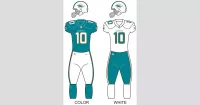Miami is a major coastal city located in Florida, United States. As of 2020, it has a population of over 442,000, making it the second-most populous city in Florida. Miami is the central hub of a large metropolitan area with an estimated 6.46 million residents, making it the sixth-largest in the U.S. Known for its impressive skyline, Miami boasts over 300 high-rises. It is the county seat of Miami-Dade County.
1900: Miami's population in 1900
In the 1900 census, Miami's population was 1,681.
February 3, 1917: Lowest temperature recorded in Miami
On February 3, 1917, Miami recorded its lowest temperature of 27 °F (-2.8 °C).
1922: Building of Coral Way in 1922
Coral Way, a historic residential neighborhood was built in 1922 between Downtown and Coral Gables.
1925: Tornado strike in Miami in 1925
A tornado struck Miami in 1925.
1925: Annexation of Coconut Grove in 1925
Coconut Grove was annexed into Miami in 1925 and is a historic neighborhood with narrow, winding roads and a heavy tree canopy.
1926: The 1926 Miami Hurricane
The 1926 Miami Hurricane slowed development in Miami.
1940: Miami's population in 1940
By 1940, Miami's population increased to 172,172 people as it became a base for U.S. defense during World War II.
July 21, 1942: Highest temperature recorded in Miami
On July 21, 1942, Miami recorded its highest temperature of 100 °F (38 °C).
1950: Miami's population in 1950
By the 1950 census, Miami's population grew to 249,276.
1956: Start date for measuring summer in Miami
From 1956, summer start date was tracked in Miami.
1959: Cuban Revolution in 1959
After the Cuban Revolution in 1959, many wealthy Cubans sought refuge in Miami, increasing the city's population.
1970: Miami population at 1970 census
According to the 1970 census, Miami's population reached 334,859.
1970: Racial Demographics in Miami in 1970
In 1970, Miami's population was reported as 45.3% Hispanic, 32.9% non-Hispanic White, and 22.7% Black.
1972: Miami in 1972
Miami's national profile expanded dramatically in the 1970s, particularly in 1972 when the region hosted both the Democratic and Republican National Conventions, and the Miami Dolphins had their undefeated season.
January 19, 1977: Snow flurries in Miami in 1977
On January 19, 1977, some parts of Miami experienced snow flurries.
1978: Calle Ocho Festival Began
The Calle Ocho Festival, the largest Latin music festival in the country, has been running since 1978 in Miami.
1985: Election of the first Cuban-born mayor
In 1985, Miami elected its first Cuban-born mayor, Xavier Suarez.
1988: Trump wins Miami-Dade County
In the 2024 presidential election in Florida, Donald Trump won Miami-Dade County by eleven points, the first time a Republican candidate had won the county since 1988.
December 1989: Coldest daytime maximum temperature in Miami in 1989
In December 1989, Miami had its coldest daytime maximum temperature of 45 °F (7 °C) during the December 1989 United States cold wave.
1990: Peak of non-Hispanic Black population in 1990
In 1990, Miami's non-Hispanic Black population peaked at almost 90,000, making up nearly a quarter of the city's population.
1996: Miami Jewish Film Festival Established
The Miami Jewish Film Festival (MJFF) was established in 1996 as an annual event held in January, screening films relating to Jewish history and culture.
1997: Tornado strike in Miami in 1997
A tornado struck Miami in 1997.
1997: End date for measuring summer in Miami
Until 1997, the end date of summer was tracked in Miami.
2000: Nadir of non-Hispanic White population in 2000
At the time of the 2000 census, the non-Hispanic White population was at its lowest point, comprising 11.8% of Miami's population.
2000: Miami's population in 2000
By the time of the 2000 census, Miami's population stood at 362,470.
2000: Population growth from 1970 to 2000
From 1970 to 2000, Miami experienced stagnant population growth due to the departure of non-Hispanic White residents and immigration from Latin America.
2001: Miami Government Bankrupt
In 2001, Miami's local government declared bankruptcy.
2002: Ron DeSantis wins Miami-Dade County
In the 2022 Florida gubernatorial election, Ron DeSantis won Miami-Dade County, the first Republican candidate to do so since 2002.
2003: Miami Hosts Free Trade Area of the Americas Negotiations
Miami was the host city of the 2003 Free Trade Area of the Americas negotiations.
2007: Miami identified as having rudest drivers
In 2007, Miami was identified as having the rudest drivers in the United States for the second year in a row, according to a poll commissioned by AutoVantage.
2007: Housing Market Crash
The housing market crash of 2007 resulted in a foreclosure crisis in the Miami area.
September 2008: Miami-Dade County Public Schools Enrollment
In September 2008, Miami-Dade County Public Schools had a student enrollment of 385,655 across 392 schools and centers.
2009: Univision Plans New Production Studio in Miami
In 2009, Univision announced plans to build a new production studio in Miami, to be called Univision Studios.
2010: Non-Hispanic White population in 2010
At the time of the 2010 census, the non-Hispanic White population rose slightly to 11.9% of Miami's population.
2010: American and Arab Ancestry Population in 2010
In 2010, 1.9% of the population considered themselves to be of only American ancestry, and 0.5% were of Arab ancestry.
2010: Origins of city residents in 2010
In 2010, 34.4% of city residents were of Cuban origin, 15.8% had a Central American background, 8.7% were of South American descent, and 4.0% had other Hispanic or Latino origins.
2010: City resident origin in 2010
In 2010, 5.6% of city residents were West Indian or Afro-Caribbean American origin.
2010: Miami Colleges Graduation
In 2010, Miami Dade College, Florida International University, University of Miami, and Barry University graduated 28,000 students.
2010: Miami ranked 44th most bike-friendly city
In 2010, Miami was ranked as the 44th most bike-friendly city in the U.S., according to Bicycling Magazine.
2010: Miami population at 2010 census
In 2010, Miami's population reached 399,457 according to the census.
2010: Asian Ancestry Population in 2010
In 2010, people of Asian ancestry accounted for 1.0% of Miami's population.
2010: Completion of Miami Intermodal Center
In 2010, the Miami Intermodal Center, a transportation hub servicing various transport options like Metrorail, Amtrak, and Miami International Airport, was completed, serving approximately 150,000 commuters and travelers.
November 2011: Norwegian Seamen's church opens new building
In November 2011, Crown Princess of Norway Mette-Marit opened a new building for the Norwegian Seamen's Church in Miami. The church serves as a center for the approximately 10,000 Scandinavians living in Florida.
2011: Miami ranked eighth-most walkable city
A 2011 study by Walk Score ranked Miami the eighth-most walkable of the 50 largest cities in the U.S.
2011: Telemundo Filming in Miami
In 2011, 85% of Telemundo's original programming was filmed in Miami.
2012: Phase I of MiamiCentral Station Completed
In 2012, Phase I of MiamiCentral Station was completed.
2012: Expected completion of Miami Central Station
In 2012, the Miami Central Station was expected to be completed, but the project experienced delays.
2012: Miami Ranks Fourth in Poverty
In the 2012 census, Miami had the fourth-highest percentage of family incomes below the federal poverty line out of all large cities in the United States.
2013: Miami's Gross Metropolitan Product
In 2013, Miami had a Gross Metropolitan Product of $257 billion, ranking 11th in the United States and 20th worldwide.
2013: Miami Herald and El Nuevo Herald Move Headquarters
In 2013, The Miami Herald and El Nuevo Herald newspapers moved from Downtown Miami to Doral.
2014: Religion in Miami in 2014
According to a 2014 Pew Research Center study, Christianity was the most-practiced religion in Miami (68%), followed by Judaism (9%), with smaller followings for Islam, Buddhism, Hinduism, and other religions. Atheism or no religious affiliation was practiced by 21% of the population.
2014: Port of Miami Tunnel Opens
In 2014, the Port of Miami Tunnel opened, connecting the MacArthur Causeway to PortMiami.
2014: Miami Central Station completion delayed
In late 2014, the completion of the Miami Central Station was again pushed back.
2015: U.S. census shows Miami lacks in owner-occupied housing, computer and internet usage, education, income, and poverty
According to the U.S. census between 2015 and 2019, Miami has shortcomings in owner-occupied housing, computer and internet usage, education, income, and poverty.
2015: Miami Transportation Statistics
In 2015, 19.9% of city of Miami households were without a car.
2015: Miami Hosts Formula E Race
In 2015, Miami hosted a one-off Formula E race.
2015: Tri-Rail part of Phase II Completed
In 2015, the Tri-Rail part of Phase II of MiamiCentral Station was completed.
2015: Miami Central Station completion further delayed
In early 2015, the completion of the Miami Central Station was further delayed.
2016: Archbishop Curley-Notre Dame High School Closure
Archbishop Curley-Notre Dame High School, located in the Miami city limits, closed in 2016.
2016: Miami Attracts Foreign Tourists
In 2016, Miami attracted the second-highest number of foreign tourists of any city in the United States, after New York City.
2016: Miami Transportation Statistics
In the 2016 American Community Survey, 72.3% of working city of Miami residents commuted by driving alone, and 18.6% of households were without a car.
2016: Trump makes gains in Miami-Dade County
In the 2016 presidential election, Donald Trump made gains among Hispanic voters in Miami-Dade County, losing the county by seven points and the city by 19 points.
2017: Miami's GDP in 2017
In 2017, Miami's metropolitan area had a gross domestic product of $344.9 billion.
2017: PortMiami Cruise Passengers
In 2017, PortMiami served 5,340,559 cruise passengers and imported 9,162,340 tons of cargo.
2017: ParkScore ranking
In the 2017 ParkScore ranking, The Trust for Public Land reported that the park system in the City of Miami was the 48th best park system among the 100 most populous U.S. cities.
2018: Miami's ranking in UBS study in 2018
According to a 2018 UBS study, Miami was the third-richest city in the U.S. and globally in purchasing power.
2018: Downtown population growth between 2010 and 2018
Between 2010 and 2018, downtown Miami's population grew nearly 40% according to an estimate by the American Community Survey.
2019: U.S. census shows Miami lacks in owner-occupied housing, computer and internet usage, education, income, and poverty
According to the U.S. census between 2015 and 2019, Miami has shortcomings in owner-occupied housing, computer and internet usage, education, income, and poverty.
2019: Miami Open moves to Hard Rock Stadium
In 2019, the Miami Open, an annual tennis tournament, was purchased by Miami Dolphins owner Stephen Ross and moved to Hard Rock Stadium.
2020: Miami's risk from climate change in 2020
According to a 2020 report, Miami is one of the most at-risk cities globally due to climate change.
2020: Miami Beta + level world city
According to the 2020 Globalization and World Cities Research Network ranking, Miami is considered a Beta + level world city.
2020: Hispanic and Latino population in 2020
As of 2020, 70.2 percent of Miami's population identified as Hispanic and Latino.
2020: Miami population at 2020 census
By the 2020 census, Miami's population grew to 442,241.
2020: Miami Park System Ranking
In its 2020 ParkScore ranking, The Trust for Public Land reported that the park system in the City of Miami was the 64th best park system among the 100 most populous U.S. cities.
2020: Non-Hispanic White population in 2020
In the 2020 census, non-Hispanic Whites made up 14.0% of Miami's population, numbering 61,829, the highest since the 1980s.
2020: Trump makes gains in Miami-Dade County
In the 2020 presidential election, Donald Trump made gains among Hispanic voters in Miami-Dade County, losing the county by seven points and the city by 19 points.
2020: Miami's First Boat-In Movie Theater Opens
Miami's first boat-in movie theater opened in 2020.
2021: Homeless count in Miami
In 2021, within the city limits of Miami, there were 555 unsheltered homeless people on the streets.
2022: Citadel Relocates Headquarters to Miami
In 2022, Citadel LLC and Citadel Securities moved their headquarters from Chicago to Miami.
2022: Homeless count in Miami-Dade County
In 2022, a Point-In-Time Homeless Count found 3,440 homeless individuals in Miami-Dade County, with 970 of them living on the streets.
2022: Visitors to Miami in 2022
In 2022, the Miami metropolitan area had over four million visitors, making it the second-most visited metropolitan statistical area in the U.S. after New York City.
2022: Ron DeSantis wins Miami-Dade County
In the 2022 Florida gubernatorial election, Ron DeSantis won Miami-Dade County, the first Republican candidate to do so since 2002.
July 2024: Miami Hosted Copa América Final
Miami hosted the 2024 Copa América final in July 2024.
2024: Working in the Magic City: Moral Economy in Early Twentieth-Century Miami
According to Bennett, Evan P. (2024) “Working in the Magic City: Moral Economy in Early Twentieth-Century Miami,” Labour / Le Travail, 21(1): 123-152.
2024: Trump wins Miami-Dade County
In the 2024 presidential election in Florida, Donald Trump won Miami-Dade County by eleven points, the first time a Republican candidate had won the county since 1988.
2025: MJFF Film Awards
As of 2025, the Miami Jewish Film Festival awards a number of film awards: Critics Jury Prize, Next Wave Jury Prize, Kadima Jury Prize, Torchbearer Award, Emerging Filmmaker Award, and the Audience Awards for Best Narrative Film, Documentary Film, and Short Film.
2026: Miami Host City for FIFA World Cup
Miami will serve as one of the U.S. host cities for the 2026 FIFA World Cup.
2070: Projected sea level rise in Miami by 2070
By 2070, Miami's sea level is projected to rise by 21 to 40 inches, increasing storm damage and threatening the water supply.
Mentioned in this timeline

Ron DeSantis is an American politician who has served as...

The Miami Dolphins are a professional American football team based...

Hard Rock Stadium located in Miami Gardens Florida is a...
Florida a state in the Southeastern United States is largely...

FIFA F d ration Internationale de Football Association is the...

A tornado is a rotating column of air connecting the...
Trending

7 months ago Jenny McCarthy Reveals Beauty Secrets at 52 and Discusses Couples Therapy

19 days ago Megan Thee Stallion Rejects 'Call of Duty' Role Due to Trauma.

7 months ago Donte DiVincenzo's impactful performance and confidence boost Timberwolves in Western Conference Finals Game 1.
Christopher Rafael Morel is a Dominican professional baseball player who currently plays third base for the Tampa Bay Rays His...
Marcus Spears nicknamed Swagu is a former NFL defensive end who played nine seasons mainly for the Dallas Cowboys He...

7 months ago George Wendt, 'Cheers' Star, Remembered Fondly After Death; Sudeikis Shares Memory
Popular

Candace Owens is an American conservative political commentator and author...

Ilhan Omar is an American politician currently serving as the...

XXXTentacion born Jahseh Dwayne Ricardo Onfroy was a controversial yet...
Matt and Ross Duffer known as the Duffer Brothers are...

Tom Cotton is an American politician and Army veteran currently...
The Kennedy Center Honors are annual awards recognizing individuals and...
